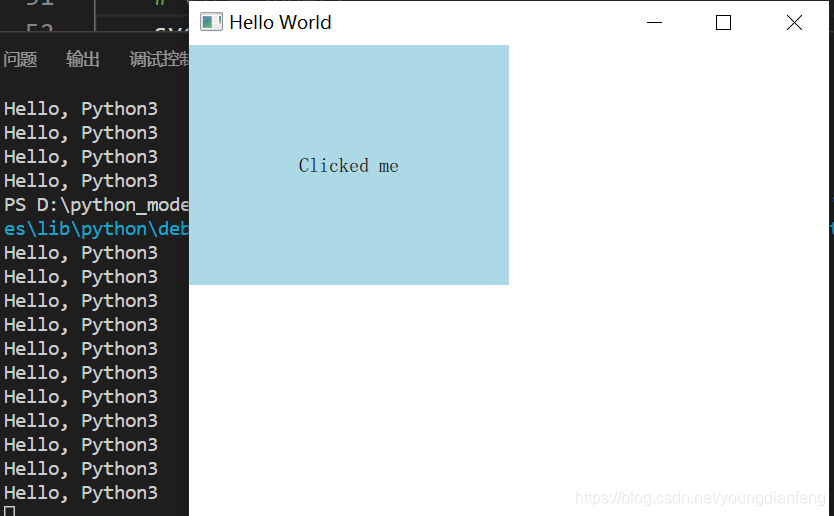QML文件
QML文件命名为Main.qml
import QtQuick 2.12
import QtQuick.Window 2.12
Window {
visible: true //此属性必须要定义
width: 640
height: 480
title: qsTr("Hello World")
Rectangle {
width: 320; height: 240
color: "lightblue"
Text {
id: txt
text: "Clicked me"
font.pixelSize: 20
anchors.centerIn: parent
}
MouseArea {
id: mouse_area
anchors.fill: parent // 有效区域
onClicked: {
con.outputString("Hello, Python3") //定义QML调用Python函数
}
}
}
}
python代码
from PyQt5.QtQuick import QQuickView
from PyQt5 import QtGui, QtWidgets, QtCore
from PyQt5.QtCore import *
from PyQt5.QtGui import *
from PyQt5.QtWidgets import *
from PyQt5 import QtQml,QtQuick
import sys
class MyClass(QObject):
@pyqtSlot(str) # 输入参数为str类型
def outputString(self, string):
print(string)
if __name__ == '__main__':
app = QtWidgets.QApplication(sys.argv)
engine = QtQml.QQmlApplicationEngine(QUrl('Main.qml'))
con = MyClass()
context = engine.rootContext()
context.setContextProperty("con", con) # 信号和槽进行绑定
sys.exit(app.exec_())
运行结果

Quick View和QML绑定
如果QML的跟元素还是window的话,那么用quick view调用会多出一个python的窗口,解决这个问题的办法就是将QML文件里的根元素改成Rectangle或者用上面的方法。
python代码
from PyQt5.QtQuick import QQuickView
from PyQt5 import QtGui, QtWidgets, QtCore
from PyQt5.QtCore import *
from PyQt5.QtGui import *
from PyQt5.QtWidgets import *
from PyQt5 import QtQml,QtQuick
import sys
class MyClass(QObject):
@pyqtSlot(str) # 输入参数为str类型
def outputString(self, string):
print(string)
if __name__ == '__main__':
app = QtWidgets.QApplication(sys.argv)
path = 'Main.qml' # 加载的QML文件
view = QQuickView()
con = MyClass()
context = view.rootContext()
context.setContextProperty("con", con) # 信号和槽进行绑定
view.setTitle('main')
view.engine().quit.connect(app.quit)
view.setSource(QUrl(path))
view.show()
sys.exit(app.exec_())
运行结果(此解决是未将QML的根元素改成Rectangle)
